Page 297 of 426
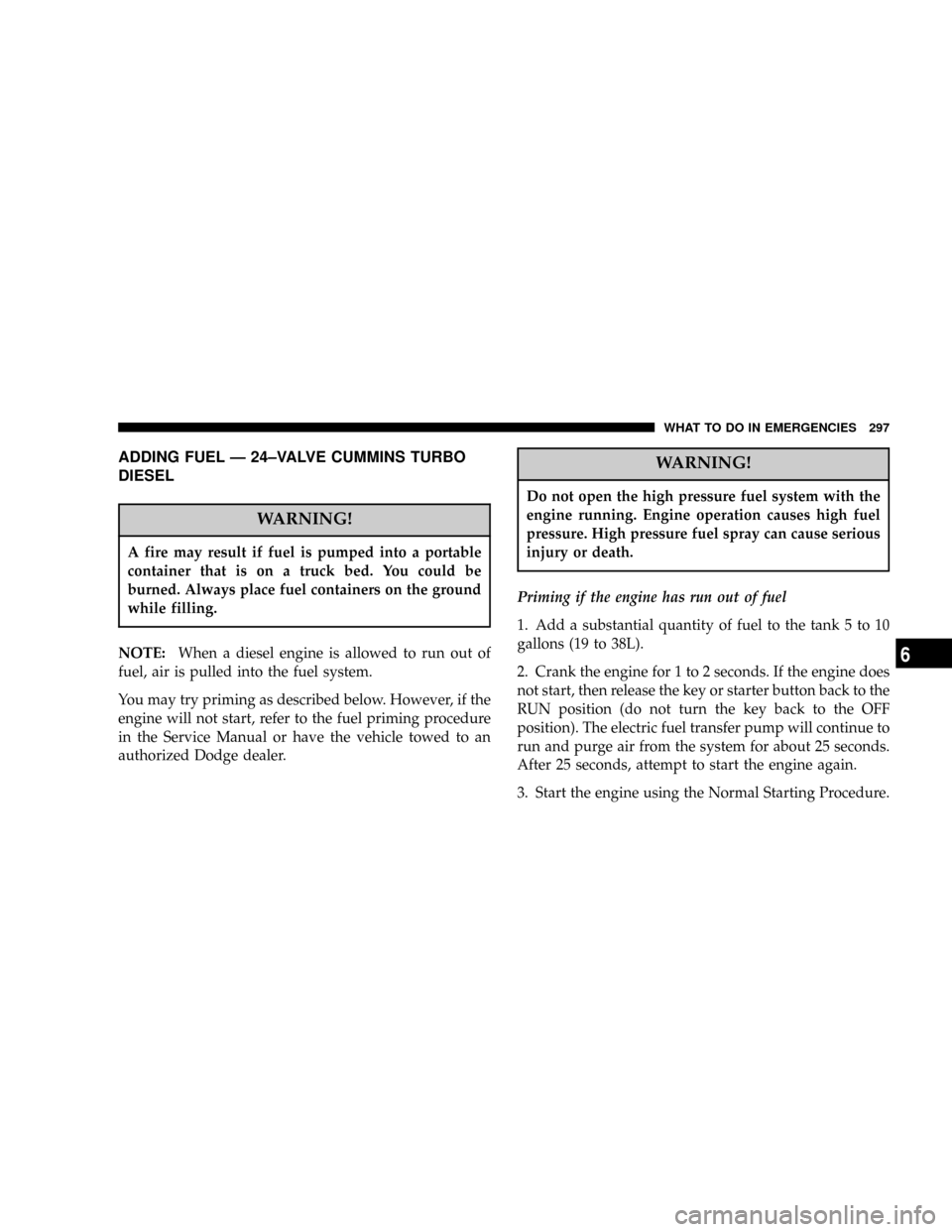
ADDING FUEL Ð 24±VALVE CUMMINS TURBO
DIESEL
WARNING!
A fire may result if fuel is pumped into a portable
container that is on a truck bed. You could be
burned. Always place fuel containers on the ground
while filling.
NOTE:When a diesel engine is allowed to run out of
fuel, air is pulled into the fuel system.
You may try priming as described below. However, if the
engine will not start, refer to the fuel priming procedure
in the Service Manual or have the vehicle towed to an
authorized Dodge dealer.
WARNING!
Do not open the high pressure fuel system with the
engine running. Engine operation causes high fuel
pressure. High pressure fuel spray can cause serious
injury or death.
Priming if the engine has run out of fuel
1. Add a substantial quantity of fuel to the tank 5 to 10
gallons (19 to 38L).
2. Crank the engine for 1 to 2 seconds. If the engine does
not start, then release the key or starter button back to the
RUN position (do not turn the key back to the OFF
position). The electric fuel transfer pump will continue to
run and purge air from the system for about 25 seconds.
After 25 seconds, attempt to start the engine again.
3. Start the engine using the Normal Starting Procedure.
WHAT TO DO IN EMERGENCIES 297
6
Page 299 of 426
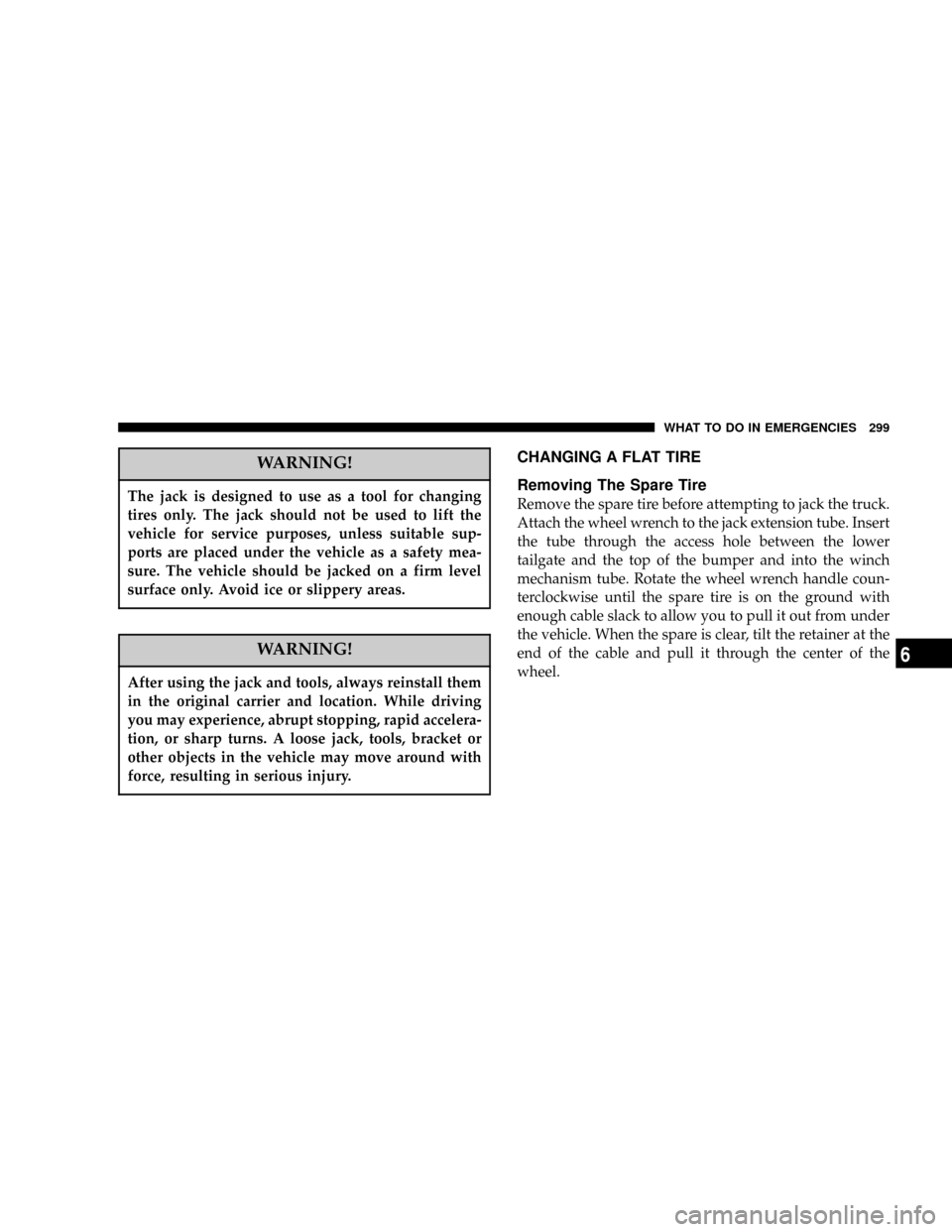
WARNING!
The jack is designed to use as a tool for changing
tires only. The jack should not be used to lift the
vehicle for service purposes, unless suitable sup-
ports are placed under the vehicle as a safety mea-
sure. The vehicle should be jacked on a firm level
surface only. Avoid ice or slippery areas.
WARNING!
After using the jack and tools, always reinstall them
in the original carrier and location. While driving
you may experience, abrupt stopping, rapid accelera-
tion, or sharp turns. A loose jack, tools, bracket or
other objects in the vehicle may move around with
force, resulting in serious injury.
CHANGING A FLAT TIRE
Removing The Spare Tire
Remove the spare tire before attempting to jack the truck.
Attach the wheel wrench to the jack extension tube. Insert
the tube through the access hole between the lower
tailgate and the top of the bumper and into the winch
mechanism tube. Rotate the wheel wrench handle coun-
terclockwise until the spare tire is on the ground with
enough cable slack to allow you to pull it out from under
the vehicle. When the spare is clear, tilt the retainer at the
end of the cable and pull it through the center of the
wheel.
WHAT TO DO IN EMERGENCIES 299
6
Page 300 of 426
It is recommended that you stow the flat or spare to
avoid tangling the loose cable.
NOTE:The winch mechanism is designed for use with
the jack extension tube only. Use of an air wrench or other
power tools is not recommended and can damage the
winch.
Tire Changing Procedure
WARNING!
Getting under a jacked-up vehicle is dangerous. The
vehicle could slip off the jack and fall on you. You
could be crushed. Never get any part of your body
under a vehicle that is on a jack. Never start or run
the engine while the vehicle is on a jack. If you need
to get under a raised vehicle, take it to a service
center where it can be raised on a lift.
Do not raise this vehicle using a bumper jack. The jack is
designed as a tool for changing tires on this vehicle only.
It is not recommended that the jack be used for service
purposes or to lift more than one wheel at a time.
300 WHAT TO DO IN EMERGENCIES
Page 305 of 426

WARNING!
Raising the vehicle higher than necessary can make
the vehicle unstable and cause an accident. It could
slip off the jack and hurt someone near it. Raise the
vehicle only enough to remove the tire.
5. Remove the wheel nuts and pull the wheel off. Install
the spare wheel and wheel nuts with the cone shaped end
of the nuts toward the wheel on 2500/3500 single rear
wheel (SRW) models. On 3500 dual rear wheel models
(DRW) the lug nuts are a two piece assembly with a flat
face. Lightly tighten the nuts. To avoid risk of forcing the
vehicle off the jack, do not fully tighten the nuts until the
vehicle has been lowered.
6. Using the wheel wrench, finish tightening the nuts
using a crisscross pattern. Correct nut tightness is 135 ft.
lbs. (183 N´m) torque for 2500/3500 single rear wheel(SRW) models and 145 ft. lbs. (197 N´m) for 3500 dual rear
wheel models. If in doubt about the correct tightness,
have them checked with a torque wrench by your dealer
or at a service station.
WARNING!
A loose tire or jack thrown forward in a collision or
hard stop could injure someone in the vehicle.
Always stow the jack parts and the extra tire and
wheel in the places provided.
7. Install wheel center cap and remove wheel blocks. Do
not install chrome or aluminum wheel center caps on the
spare wheel. This may result in cap damage.
8. Lower the jack to its fully closed position. If the jack
will not lower by turning the dial (thumb wheel) by
WHAT TO DO IN EMERGENCIES 305
6
Page 317 of 426
MAINTAINING YOUR VEHICLE
CONTENTS
mEngine Compartment....................320
N5.9L/5.9L HO Cummins Turbo Diesel.......320
mOnboard Diagnostic System (OBD II).........321
mReplacement Parts......................322
mDealer Service.........................322
mService Information.....................322
mMaintenance Procedures..................325
NEngine Oil..........................325
NDrive Belt...........................331NEngine Air Cleaner Filter................331
NDraining Fuel/Water Separator Filter.......334
NMaintenance Free Batteries...............336
NAir Conditioner Maintenance.............338
NPower Steering Ð Fluid Check............339
NFront Suspension Ball Joints..............340
NSteering Linkage Ð Inspection............340
NFront Axle Universal Drive Joints And Pivot
Bearings............................340
7
Page 321 of 426
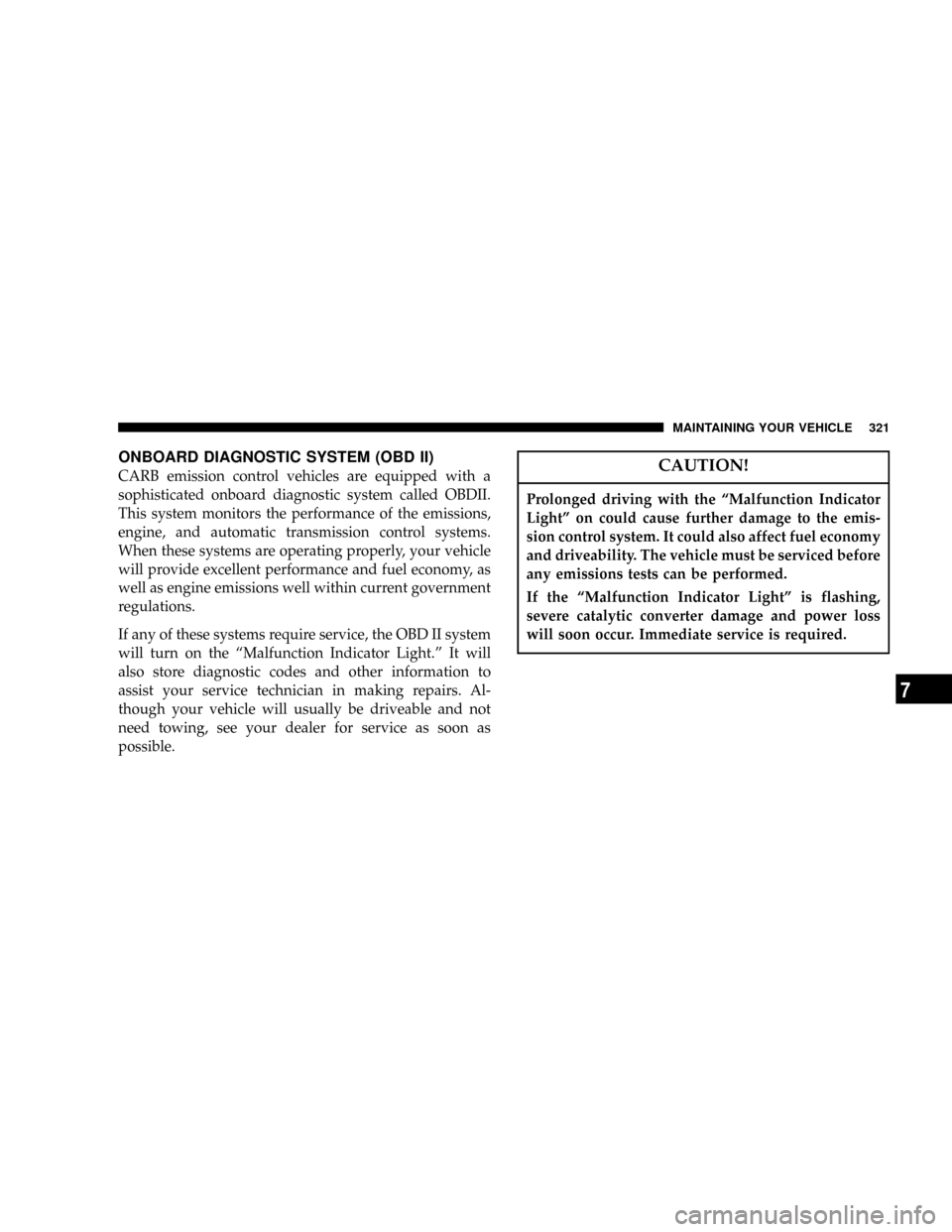
ONBOARD DIAGNOSTIC SYSTEM (OBD II)
CARB emission control vehicles are equipped with a
sophisticated onboard diagnostic system called OBDII.
This system monitors the performance of the emissions,
engine, and automatic transmission control systems.
When these systems are operating properly, your vehicle
will provide excellent performance and fuel economy, as
well as engine emissions well within current government
regulations.
If any of these systems require service, the OBD II system
will turn on the ªMalfunction Indicator Light.º It will
also store diagnostic codes and other information to
assist your service technician in making repairs. Al-
though your vehicle will usually be driveable and not
need towing, see your dealer for service as soon as
possible.CAUTION!
Prolonged driving with the ªMalfunction Indicator
Lightº on could cause further damage to the emis-
sion control system. It could also affect fuel economy
and driveability. The vehicle must be serviced before
any emissions tests can be performed.
If the ªMalfunction Indicator Lightº is flashing,
severe catalytic converter damage and power loss
will soon occur. Immediate service is required.
MAINTAINING YOUR VEHICLE 321
7
Page 322 of 426
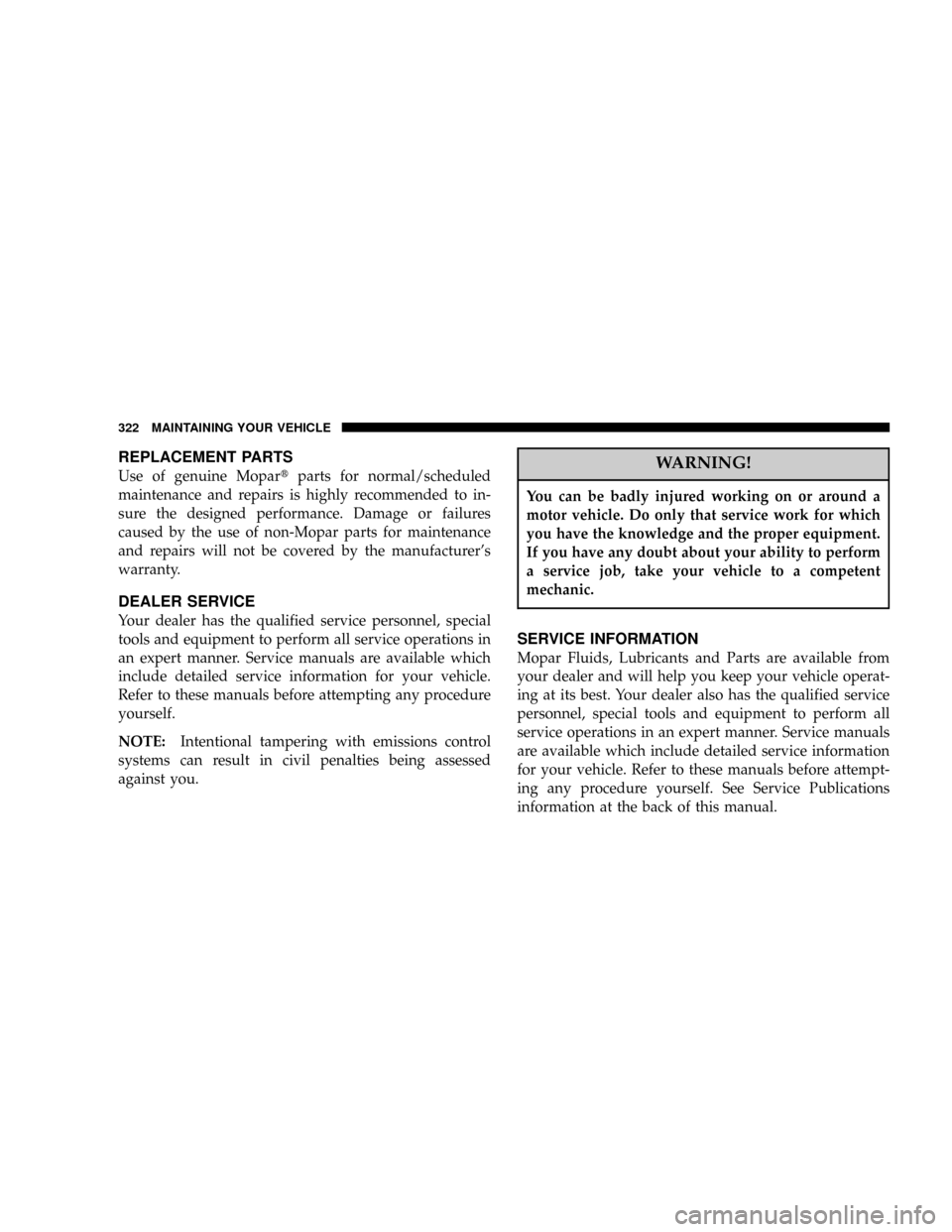
REPLACEMENT PARTS
Use of genuine Mopartparts for normal/scheduled
maintenance and repairs is highly recommended to in-
sure the designed performance. Damage or failures
caused by the use of non-Mopar parts for maintenance
and repairs will not be covered by the manufacturer's
warranty.
DEALER SERVICE
Your dealer has the qualified service personnel, special
tools and equipment to perform all service operations in
an expert manner. Service manuals are available which
include detailed service information for your vehicle.
Refer to these manuals before attempting any procedure
yourself.
NOTE:Intentional tampering with emissions control
systems can result in civil penalties being assessed
against you.
WARNING!
You can be badly injured working on or around a
motor vehicle. Do only that service work for which
you have the knowledge and the proper equipment.
If you have any doubt about your ability to perform
a service job, take your vehicle to a competent
mechanic.
SERVICE INFORMATION
Mopar Fluids, Lubricants and Parts are available from
your dealer and will help you keep your vehicle operat-
ing at its best. Your dealer also has the qualified service
personnel, special tools and equipment to perform all
service operations in an expert manner. Service manuals
are available which include detailed service information
for your vehicle. Refer to these manuals before attempt-
ing any procedure yourself. See Service Publications
information at the back of this manual.
322 MAINTAINING YOUR VEHICLE
Page 323 of 426
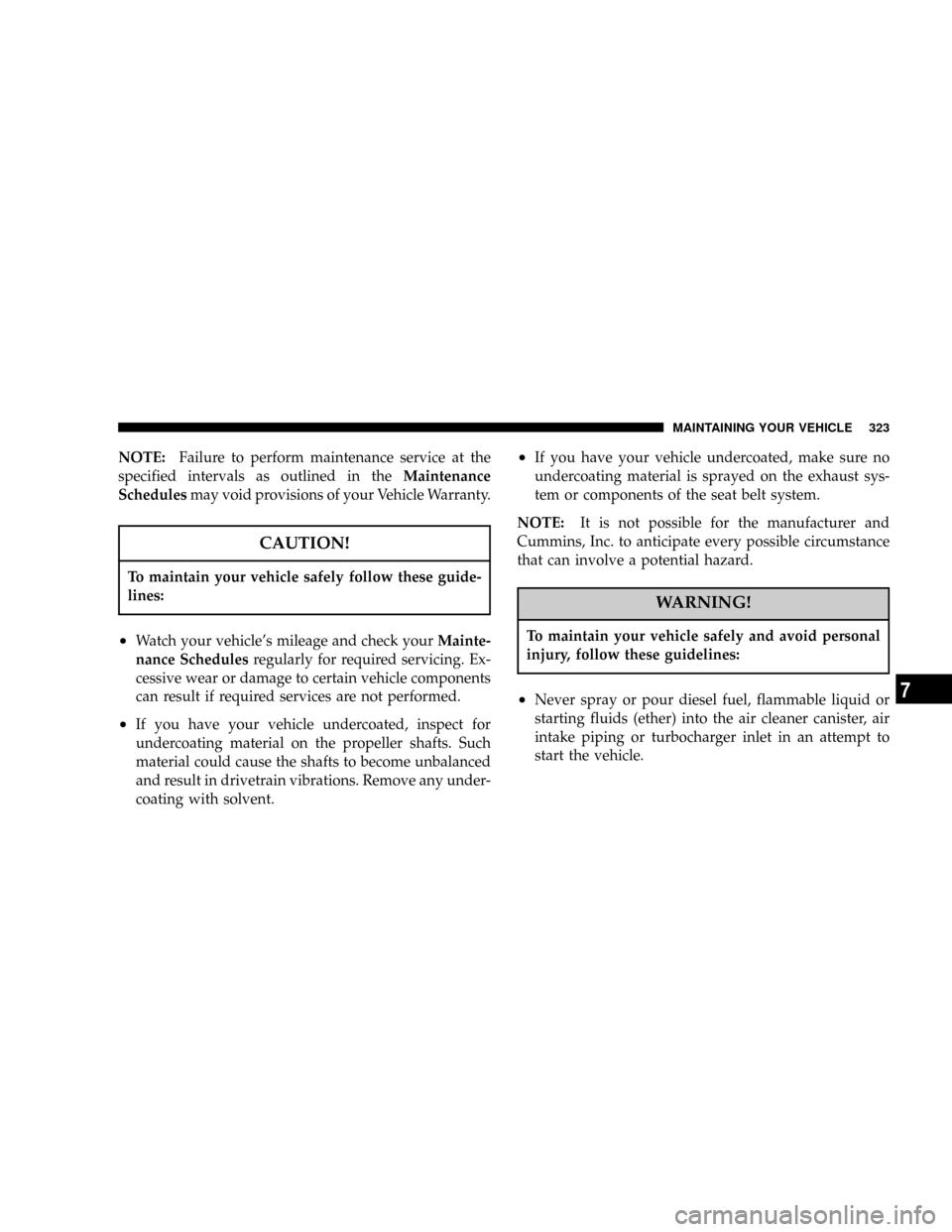
NOTE:Failure to perform maintenance service at the
specified intervals as outlined in theMaintenance
Schedulesmay void provisions of your Vehicle Warranty.
CAUTION!
To maintain your vehicle safely follow these guide-
lines:
²Watch your vehicle's mileage and check yourMainte-
nance Schedulesregularly for required servicing. Ex-
cessive wear or damage to certain vehicle components
can result if required services are not performed.
²If you have your vehicle undercoated, inspect for
undercoating material on the propeller shafts. Such
material could cause the shafts to become unbalanced
and result in drivetrain vibrations. Remove any under-
coating with solvent.
²If you have your vehicle undercoated, make sure no
undercoating material is sprayed on the exhaust sys-
tem or components of the seat belt system.
NOTE:It is not possible for the manufacturer and
Cummins, Inc. to anticipate every possible circumstance
that can involve a potential hazard.
WARNING!
To maintain your vehicle safely and avoid personal
injury, follow these guidelines:
²Never spray or pour diesel fuel, flammable liquid or
starting fluids (ether) into the air cleaner canister, air
intake piping or turbocharger inlet in an attempt to
start the vehicle.
MAINTAINING YOUR VEHICLE 323
7